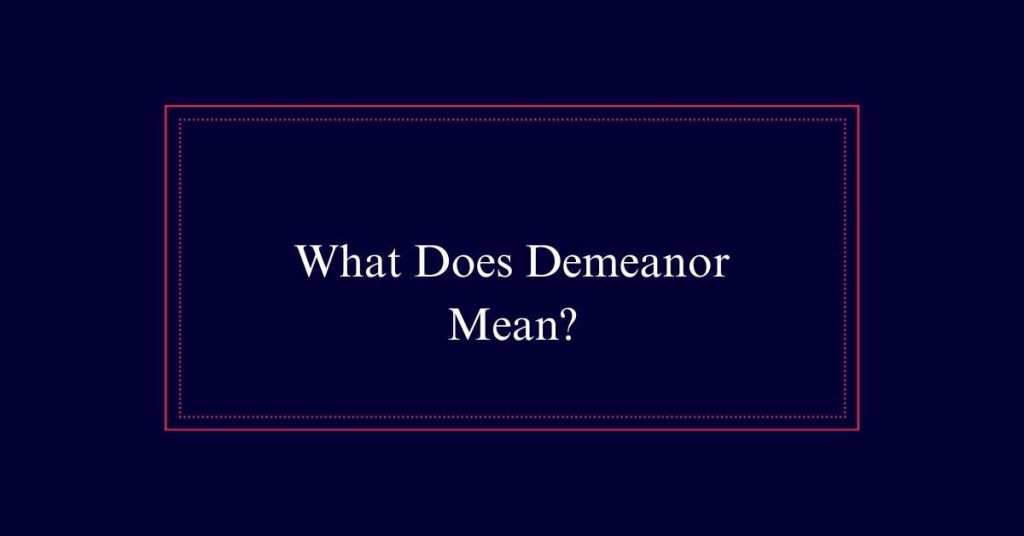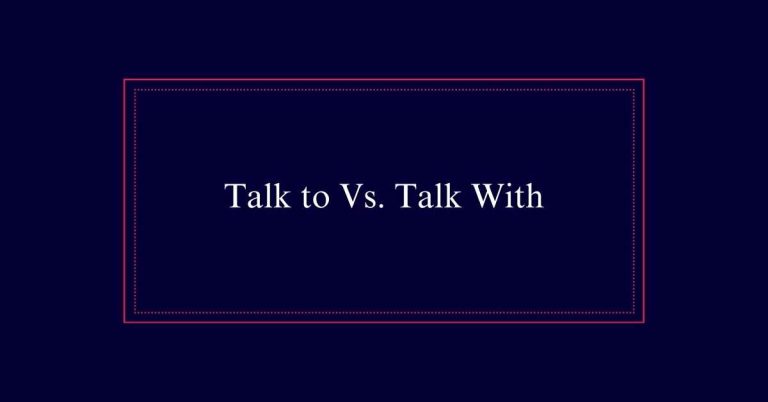What Does Demeanor Mean?
Demeanor is essential for an individual’s outward behavior, including their posture, speech, and facial expressions. It encompasses how one presents themselves in various situations, influencing communication and relationships.
A friendly demeanor can foster trust and cooperation, while an unfriendly demeanor can create tension. It’s worth mentioning the spelling variation: ‘demeanor’ in the U.S. and ‘demeanour’ in the U.K. Common misspellings include ‘demanor’ and ‘demeaner.’
Definition of Demeanor
What exactly does the term ‘demeanor’ mean?
Demeanor refers to one’s outward behavior or conduct. It encompasses aspects like posture, speech, and facial expressions. For instance, a friendly demeanor might include smiling and making eye contact, while an unfriendly demeanor could involve crossed arms and curt answers.
The term has its roots in the Latin word ‘minari,’ which means ‘to threaten.’ Over time, it evolved to mean ‘to conduct oneself.’ In Middle English, ‘demenen’ meant to conduct oneself. Today, demeanor is commonly used to describe how someone presents themselves in various situations. It plays a significant role in how others perceive and interact with an individual.
Elements of Demeanor
Understanding the elements of demeanor involves examining specific aspects such as posture, speech, and facial expressions. Posture refers to how one stands or sits. An upright posture can convey confidence, while slouching may suggest disinterest.
Speech includes tone, volume, and pace. Clear and calm speech often indicates self-assurance, whereas hurried or mumbled words might imply nervousness.
Facial expressions reveal emotions through movements like smiling or frowning. A genuine smile can show friendliness, while a furrowed brow may indicate concern or displeasure.
Friendly Vs. Unfriendly Demeanor
A person’s demeanor can be classified as friendly or unfriendly based on their outward behavior. Friendly demeanor includes actions like smiling, making eye contact, and using open body language. These behaviors can create a welcoming atmosphere and make interactions more pleasant.
On the other hand, an unfriendly demeanor is characterized by actions such as crossing arms, avoiding eye contact, and offering short, curt responses. Such behavior can create tension and make social or professional interactions uncomfortable.
Understanding these differences is essential for effective communication. Friendly demeanor fosters positive relationships and collaboration, while an unfriendly demeanor can hinder communication and lead to misunderstandings.

Spelling Variations
The word ‘demeanor’ has several spelling variations, with ‘demeanour’ being commonly used outside the United States. In the U.S., ‘demeanor’ is the preferred spelling, aligning with American English conventions.
Conversely, ‘demeanour’ follows British English standards and is prevalent in countries such as the United Kingdom, Canada, and Australia. These variations are minor and do not alter the meaning of the word. Both spellings are correct and accepted in formal writing.
Common Misspellings
Common misspellings of ‘demeanor’ include ‘demenor,’ ‘deamenor,’ and ‘demeaner.’ These errors are often due to the word’s unusual spelling and pronunciation.
The correct spelling is ‘demeanor’ in American English and ‘demeanour’ in British English. The double ‘e’ and the ending ‘-or’ can be confusing for many people.
To avoid these mistakes, it helps to remember the root word ‘minari,’ which does not contain an extra ‘e’ or ‘a.’ Using mnemonic devices, such as associating ‘demeanor’ with ‘de-mean-or’ (to recall ‘mean’ behavior) can also aid in proper spelling.
Use in Sentences
In the workplace, demeanor can greatly influence how colleagues perceive an individual. For example, a friendly demeanor, characterized by smiling and maintaining eye contact, can foster positive interactions. Conversely, an unfriendly demeanor, such as crossing arms and giving short answers, may create a negative impression.
Demeanor is not only about facial expressions but also includes posture and speech. A professional demeanor, marked by confident posture and clear communication, is often essential in business settings.
In sports, athletes like James Guy exhibit a confident demeanor, which can intimidate opponents and inspire teammates. Politicians are also judged by their demeanor; Hillary Clinton’s serious demeanor was a notable aspect of her public image.
Historical Background
Understanding the historical background of the term ‘demeanor’ provides insight into its current usage and significance. The word originates from the Latin term ‘minari,’ which means ‘to threaten.’
Over time, this term evolved in Middle English to ‘demenen,’ meaning ‘to conduct oneself.’ This evolution marked a shift from a threatening posture to an overall behavior or conduct. The suffix ‘-or’ was later added to form the noun ‘demeanor.’
Historically, the term has shifted from a negative connotation to a more neutral or descriptive one. This historical journey highlights how language adapts to cultural changes, influencing how we describe outward behavior today.
Evolution of Meaning
The meaning of ‘demeanor’ has evolved dramatically from its original connotation of threat to its current interpretation of overall behavior. Initially derived from the Latin word ‘minari,’ which means ‘to threaten,’ the term underwent significant transformation. In Middle English, ‘demenen’ referred to how one conducted oneself. Over time, this evolved into the modern understanding of demeanor as a reflection of outward behavior, including posture, speech, and facial expressions.
| Period | Original Meaning | Evolved Meaning |
|---|---|---|
| Latin | To threaten | Not applicable |
| Middle English | To conduct oneself | To behave |
| Modern English | Not applicable | Overall behavior |
Cultural Significance
Demeanor plays a pivotal role in shaping how individuals are perceived in various cultural contexts. Different cultures have unique expectations for behavior. In Japan, a calm and respectful demeanor is highly valued.
In Italy, expressive gestures and animated conversation are common. These cultural norms influence how demeanor is interpreted. A smile in one culture might signify friendliness, while in another, it could be seen as insincere.
Understanding these differences is essential for effective interaction. Misinterpreting someone’s demeanor can lead to misunderstandings. Being aware of cultural nuances is key in forming better relationships and avoiding conflicts.
Professional Importance
Recognizing cultural nuances in demeanor becomes particularly important in professional settings. A professional demeanor can have a considerable impact on workplace dynamics and career advancement. Understanding and adapting one’s demeanor to align with organizational culture fosters positive interactions and effective communication.
Key aspects include:
- First Impressions: A well-composed demeanor can set a positive tone and establish credibility.
- Conflict Resolution: Calm and respectful behavior aids in resolving disputes amicably.
- Leadership: Leaders with a confident and approachable demeanor inspire trust and motivate teams.
Employers often evaluate demeanor during interviews and ongoing performance reviews. A positive, professional demeanor can open doors to new opportunities and enhance workplace relationships.






